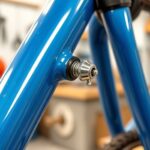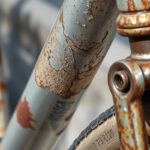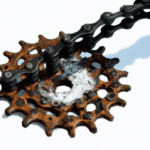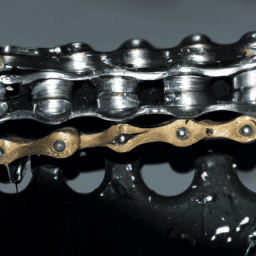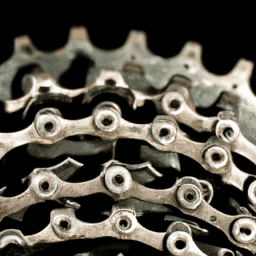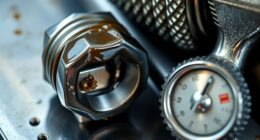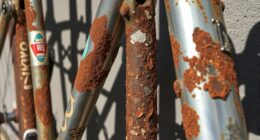To keep your beach cruiser in top shape, regularly clean it with a damp cloth and use protective sprays to prevent rust. Lubricate the chain and check tire pressure often to guarantee smooth rides. Inspect bolts, brakes, and wheels monthly, replacing worn parts promptly. Carry a basic repair kit for emergencies and store your bike in a dry place to avoid corrosion from saltwater. Keep following these tips to learn more ways to maintain your bike properly.
Key Takeaways
- Regularly clean your bike and apply protective sprays to prevent rust and corrosion.
- Lubricate the chain every 100-200 miles and check for squeaks or rust.
- Maintain proper tire pressure, inspect tires and wheels for damage, and keep rims clean.
- Tighten bolts and fasteners regularly, focusing on critical components like seat posts and handlebars.
- Carry an emergency repair kit and schedule professional inspections annually for comprehensive maintenance.
Proper Cleaning and Rust Prevention

To keep your beach cruiser in top shape and prevent rust, it’s essential to clean it regularly. You need to maintain your bike by wiping it down with a damp cloth after each ride to remove salt, sand, and moisture that can cause corrosion. Use gentle cleaning agents and soft brushes to thoroughly clean the frame, chain, and wheels, paying close attention to salt residue and dirt buildup. Applying a silicone or linseed oil-based protective spray monthly creates a barrier against rust and moisture. Cover your bike with a breathable cover or store it indoors in a dry, cool place to limit exposure to humidity and salty air. Regular inspections and cleaning of internal parts, along with proper maintenance, will help you keep your bike rust-free and ready to ride. Ensuring proper ventilation and storage can further reduce the risk of corrosion and extend the life of your cruiser. Additionally, periodic application of protective coatings can enhance the durability of your bike’s frame against harsh environmental elements. Incorporating sustainable maintenance practices can also contribute to longer-lasting bike components and a more eco-friendly approach to upkeep. Regularly checking and replenishing lubricants is crucial to keep moving parts functioning smoothly and prevent wear. For added protection, consider using rust inhibitors to provide extra defense against moisture and salt.
Lubrication and Mechanical Maintenance

Keeping your beach cruiser’s mechanical parts in good condition is essential for smooth riding and longevity. Regular lubrication helps prevent wear and tear on vital components like the chain, derailleurs, brake levers, and gear shifters. Apply bicycle-specific lubricant to the chain every 100-200 miles or when you notice squeaking or rust. Before re-lubricating, use a degreaser to thoroughly clean dirt and old grease from the drivetrain. Check and tighten bolts and nuts on moving parts at least once a month to maintain peak function. Light oil on pivot points and brake levers ensures smooth operation and reduces friction. Regularly inspect your bike’s mechanical parts for signs of damage, rust, or wear, and replace or repair components promptly to keep everything working smoothly. Essential oils can also be used to maintain your overall well-being, supporting your health during rides. Additionally, understanding the skin types of your skin can help you choose the most appropriate maintenance and protective measures for your bike and body. Incorporating sound healing science principles, such as applying calming vibrations, can also contribute to a more relaxing riding experience and mental clarity. Recognizing the importance of mental wellbeing can further improve your overall riding experience and personal health. Regularly inspecting your bike’s components can also help identify electric power issues early, especially if your cruiser has any electric assist features.
Tire and Wheel Care
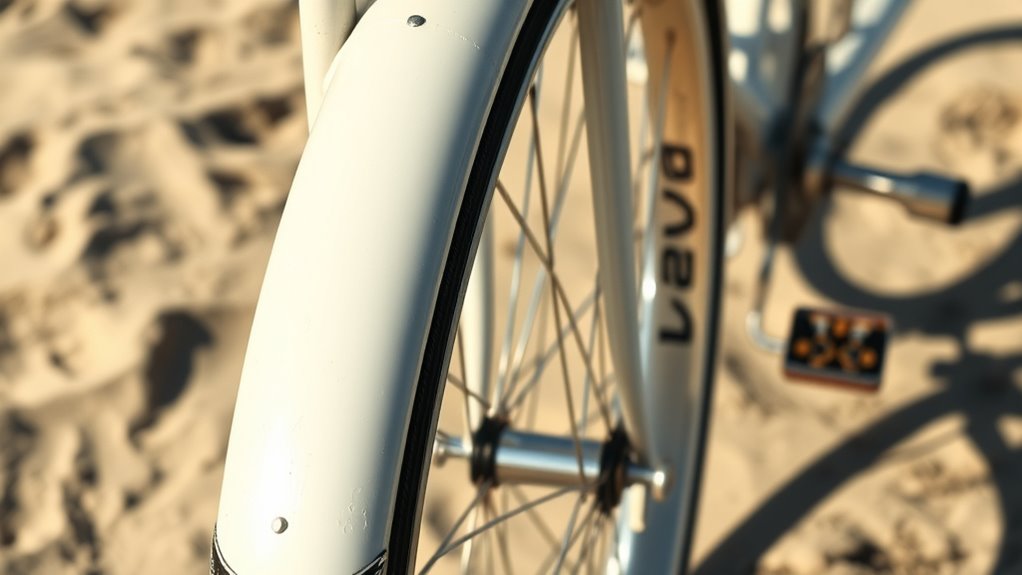
Regular tire and wheel care is crucial for maintaining safe and efficient rides on your beach cruiser. You should regularly inspect your tires for wear, cuts, and embedded debris that can affect safety and performance. Check your tire pressure often, aiming for the manufacturer’s recommended PSI, usually between 40-60 PSI, to improve ride quality and efficiency. Keep an eye on your wheel rims for dents or cracks, and rotate your wheels periodically to prevent wobbling. Additionally, clean your wheel rims and spokes to avoid buildup that can cause imbalance. Remember to maintain your bike chain, as a well-lubricated chain reduces strain on the wheels and ensures smooth pedaling. Proper tire and wheel care keep your cruiser rolling smoothly on sand and uneven terrain. Implementing regular maintenance routines can further extend the lifespan of your bicycle components and ensure a safe riding experience. Staying informed about industry trends can help you adopt new techniques and tools for better care. Incorporating knowledge about antioxidants and overall health benefits can also inspire you to keep your bike in top shape for longer rides and outdoor adventures. Ensuring the correct tire pressure is essential for optimal performance and safety on different terrains. Don’t forget that using the right cleaning methods can also prevent damage and prolong your wheels’ lifespan.
Battery and Electrical System Care
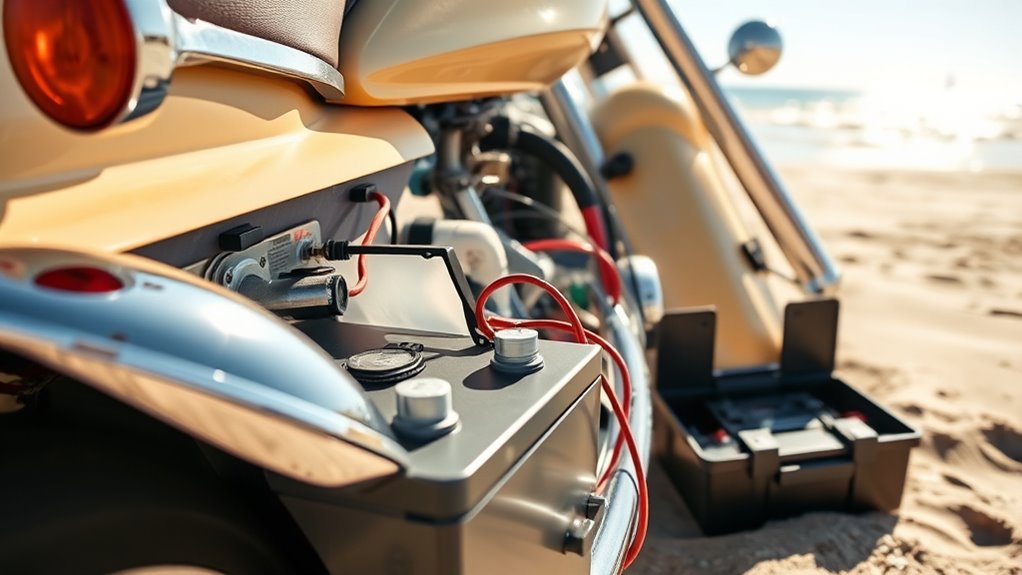
Wondering how to keep your e-bike’s electrical system in top shape? Proper battery care is key to maintaining peak performance. Always follow the manufacturer’s instructions for charging to prevent overcharging and damage. Charge your battery promptly after each ride, ideally to full capacity, and avoid leaving it partially charged for long periods. Store the battery in a cool, dry place away from sunlight and extreme temperatures to extend its lifespan. Regularly check its health, and replace it if you notice a decline in range or power. Use only approved chargers, and unplug the battery once fully charged. Keeping your battery in good condition can also be supported by understanding the battery chemistry, which influences durability and safety. To ensure proper air purifier maintenance, regularly clean or replace filters according to the manufacturer’s recommendations. Maintaining proper battery storage practices can significantly improve its longevity. Proper battery maintenance is essential for ensuring consistent performance and safety. Keep your battery in good condition with this simple table:
| Action | Benefit |
|---|---|
| Follow manufacturer’s instructions | Prevents damage and prolongs life |
| Charge fully after rides | Maintains peak performance |
| Store in cool, dry place | Extends battery lifespan |
| Monitor health regularly | Ensures reliable performance |
| Use approved chargers | Avoids potential damage |
Enhancing Range and Longevity

To get the most out of your beach cruiser, make sure your tires are inflated to the recommended PSI, which can boost efficiency and extend battery life. Using lightweight gears when climbing hills helps reduce motor strain and conserves power, giving you a longer ride. Regularly checking and adjusting these settings keeps your bike running smoothly and helps it last longer. Incorporating wall organization systems can also keep your storage tidy and accessible, preventing clutter that might hinder your riding gear.
Optimize Tire Pressure
Maintaining the correct tire pressure is essential for maximizing your beach cruiser’s range and lifespan. Proper tire pressure, usually between 50-70 PSI for beach cruiser bikes, ensures smooth rides and reduces the risk of flats. When your tires are under-inflated, you’ll notice increased resistance, making pedaling harder and draining your battery faster. Over-inflated tires can lead to a rough ride and higher chances of punctures on uneven surfaces. To keep your bike in tip-top shape, check your tire pressure before each ride and make adjustments as needed. Doing so helps you:
- Improve ride efficiency
- Prevent flats and punctures
- Extend tire lifespan
- Maintain your beach cruiser’s peak performance
Regular maintenance of tire pressure is a simple step to enjoy safer, longer-lasting rides.
Use Appropriate Gears
Using the right gears while riding your beach cruiser can considerably boost your bike’s efficiency and lifespan. Proper gear shifting helps you select ideal gear ratios for different terrains, reducing strain on the drivetrain and conserving battery life. Avoid staying in high or low gears for too long to prevent unnecessary wear on the chain and gears. Smooth, timely shifts distribute pedaling effort evenly, preventing mechanical stress. Here’s a simple guide:
| Terrain | Recommended Gear Ratio | Effect |
|---|---|---|
| Uphill | Lighter gears | Less strain, longer range |
| Flat | Moderate gears | Efficient pedaling |
| Downhill | Heavier gears | Maintain control, save wear |
Using appropriate gears ensures consistent performance and extends your cruiser’s longevity.
Checking and Tightening Bolts and Attachments

Regularly checking and tightening all bolts and attachments on your beach cruiser is essential for safe and smooth rides. You should inspect each bolt, nut, and fastener, especially after riding on rough terrain or beach sand. Use a proper wrench or Allen key to tighten any loose bolts, but avoid over-tightening to prevent stripping threads or damaging components. Focus on critical points like seat posts, handlebars, and wheel axles, since loose fittings can compromise safety and ride quality. Also, check for rust or corrosion around fasteners, replacing any that show significant deterioration. To maintain your bike’s integrity, schedule routine inspections—monthly or before long beach rides—to ensure all bolts are secure and attachments are stable. Staying vigilant keeps your cruiser safe and reliable.
Carrying a Repair Kit for Emergencies

Carrying a well-stocked repair kit guarantees you’re prepared for sudden bike issues on the beach. Make sure it includes essential tools like a spoke wrench, tire levers, and a portable pump. Keeping spare inner tubes, a patch kit, and lubricants handy lets you fix flats and maintain your bike quickly.
Essential Repair Kit Items
Having a well-stocked repair kit on hand is essential for handling unexpected bike issues while at the beach. Your repair kit should include key items like a foldable spare tire, spare bolts, a chain link, lubricant, and a spoke wrench for quick fixes. These tools allow you to address common problems without hassle. Additionally, pack versatile tools such as a multi-tool, duct tape, and a tire pump to handle roadside repairs efficiently. Keep a small flashlight and a set of Allen wrenches for low-light or tight-space repairs. Regularly check and restock your kit to replace used items and add new tools. By carrying these essential repair kit items, you’ll stay prepared, minimizing ride disruptions and saving time during unexpected bike malfunctions.
Emergency Repair Procedures
When you’re out on the beach, unexpected bike issues can happen at any moment, so it’s essential to have a well-prepared repair kit within easy reach. Your repair kit should include bike parts like a spare tube, tire levers, and a pump for quick fixes such as fixing a flat tire or adjusting brakes. Familiarize yourself with basic repair techniques like tightening loose bolts or patching a puncture so you can handle emergencies confidently. Regularly check and replenish your repair kit items before beach rides to ensure everything’s functional and ready. Keep your repair kit accessible, either attached to your bike or in a small backpack, so you can quickly address problems without stopping your ride or panicking. This preparation keeps your ride smooth and enjoyable.
Scheduling Regular Bike Inspections
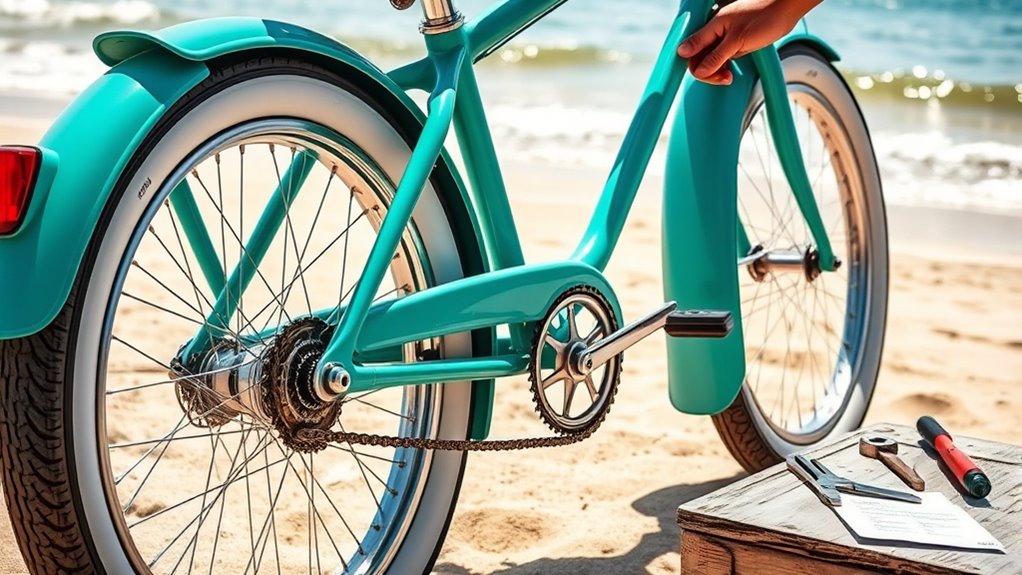
How often should you schedule professional inspections for your beach cruiser? At least once a year, you should have a thorough inspection to catch hidden issues and ensure proper maintenance. During these visits, a mechanic will check critical parts like the brakes, gears, and chain, ensuring everything functions smoothly. Regular inspections help prevent unexpected breakdowns and extend your bike’s lifespan.
Remember to:
- Inspect for rust, loose bolts, and worn parts
- Verify tire pressure and brake performance
- Clean and lubricate the chain, gears, and cables
- Tighten all nuts and bolts, especially on the wheels and headset
Scheduling these professional checkups guarantees your cruiser remains safe, reliable, and in top shape for every ride.
Protecting Your Bike From Saltwater and Corrosion

Saltwater exposure can quickly accelerate corrosion on your beach cruiser if you don’t take proper precautions. After riding near the ocean, rinse your bike thoroughly with fresh water to wash away residual salt that can cause rust. Applying a protective coating of silicone spray or linseed oil-based protectant on metal parts creates a moisture barrier, reducing saltwater contact and corrosion risk. Regularly inspecting and cleaning welds and joints helps catch early signs of rust or salt buildup, making maintenance easier. Consider using corrosion-resistant components, like anodized or coated parts, to boost durability in salty environments. When not in use, store your cruiser in a dry, sheltered spot away from direct salt spray and humidity. Proper maintenance minimizes corrosion, prolongs your bike’s lifespan, and keeps it riding smoothly.
Frequently Asked Questions
How to Maintain a Cruiser Bike?
To keep your cruiser bike in top shape, you should regularly inspect and tighten all bolts and nuts to guarantee stability. Clean the frame, chain, and wheels after each beach ride to remove salt and sand. Lubricate the chain weekly with bike-specific oil, and check tire pressure to match the recommended PSI. Schedule annual professional tune-ups to catch issues early and keep your cruiser running smoothly.
What Is the Downside of a Cruiser Bike?
Imagine you’re planning a quick ride through tight city streets, but your cruiser’s wide tires and bulky frame make steering tricky. The downside? Cruiser bikes are less agile, especially in tight spaces. Their relaxed geometry and heavier weight can slow you down and make handling tiring over long distances. Plus, limited gears mean climbing steep hills becomes a real challenge, reducing overall versatility for varied terrains.
Why Is My Beach Cruiser so Hard to Pedal?
If your beach cruiser is hard to pedal, it’s likely due to issues like low tire pressure, which increases rolling resistance. Also, check if the chain is dirty or rusty, causing extra friction. Make sure the brake calipers aren’t rubbing against the wheel, and ensure your gears and cables aren’t misaligned or too tight. Worn bearings or bottom brackets can also make pedaling more difficult. Regular maintenance resolves these problems.
How Many Miles Do Cruiser Bikes Last?
You wonder how long your cruiser bike will last, but the answer isn’t one-size-fits-all. With proper care, a quality cruiser can reach 10,000 to 20,000 miles, and even beyond. However, riding conditions like beach salt and sand can shorten its life. Regular tune-ups, cleaning, and storage help extend its mileage, ensuring your cruiser stays smooth and reliable for many adventures ahead.
Conclusion
Think of your beach cruiser as a loyal ship sailing the coastal waters. With proper care—cleaning, lubrication, and inspections—you’re steering clear of rust and breakdowns. Keep your tools onboard like a trusty compass, ready for any storm. Regular maintenance is your lighthouse, guiding your bike safely through the seasons. By tending to your cruiser, you’ll ensure smooth sailing and endless adventures along the shoreline, making every ride feel like a breezy, carefree voyage.


